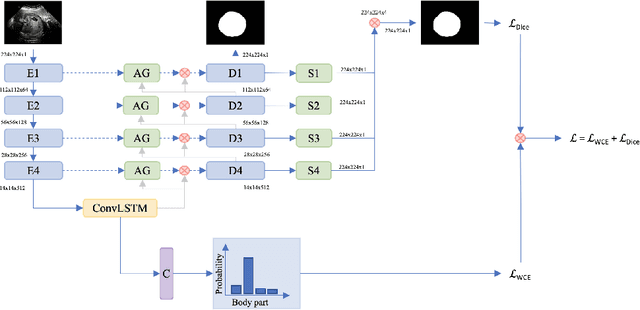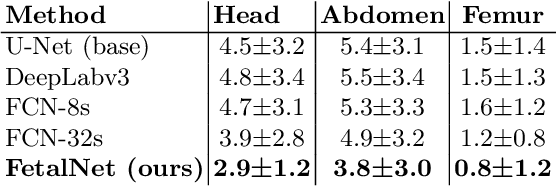Adam Klasa
Deep Learning Fetal Ultrasound Video Model Match Human Observers in Biometric Measurements
May 27, 2022Abstract:Objective. This work investigates the use of deep convolutional neural networks (CNN) to automatically perform measurements of fetal body parts, including head circumference, biparietal diameter, abdominal circumference and femur length, and to estimate gestational age and fetal weight using fetal ultrasound videos. Approach. We developed a novel multi-task CNN-based spatio-temporal fetal US feature extraction and standard plane detection algorithm (called FUVAI) and evaluated the method on 50 freehand fetal US video scans. We compared FUVAI fetal biometric measurements with measurements made by five experienced sonographers at two time points separated by at least two weeks. Intra- and inter-observer variabilities were estimated. Main results. We found that automated fetal biometric measurements obtained by FUVAI were comparable to the measurements performed by experienced sonographers The observed differences in measurement values were within the range of inter- and intra-observer variability. Moreover, analysis has shown that these differences were not statistically significant when comparing any individual medical expert to our model. Significance. We argue that FUVAI has the potential to assist sonographers who perform fetal biometric measurements in clinical settings by providing them with suggestions regarding the best measuring frames, along with automated measurements. Moreover, FUVAI is able perform these tasks in just a few seconds, which is a huge difference compared to the average of six minutes taken by sonographers. This is significant, given the shortage of medical experts capable of interpreting fetal ultrasound images in numerous countries.
* Published at Physics in Medicine & Biology
FetalNet: Multi-task deep learning framework for fetal ultrasound biometric measurements
Jul 14, 2021



Abstract:In this paper, we propose an end-to-end multi-task neural network called FetalNet with an attention mechanism and stacked module for spatio-temporal fetal ultrasound scan video analysis. Fetal biometric measurement is a standard examination during pregnancy used for the fetus growth monitoring and estimation of gestational age and fetal weight. The main goal in fetal ultrasound scan video analysis is to find proper standard planes to measure the fetal head, abdomen and femur. Due to natural high speckle noise and shadows in ultrasound data, medical expertise and sonographic experience are required to find the appropriate acquisition plane and perform accurate measurements of the fetus. In addition, existing computer-aided methods for fetal US biometric measurement address only one single image frame without considering temporal features. To address these shortcomings, we propose an end-to-end multi-task neural network for spatio-temporal ultrasound scan video analysis to simultaneously localize, classify and measure the fetal body parts. We propose a new encoder-decoder segmentation architecture that incorporates a classification branch. Additionally, we employ an attention mechanism with a stacked module to learn salient maps to suppress irrelevant US regions and efficient scan plane localization. We trained on the fetal ultrasound video comes from routine examinations of 700 different patients. Our method called FetalNet outperforms existing state-of-the-art methods in both classification and segmentation in fetal ultrasound video recordings.
 Add to Chrome
Add to Chrome Add to Firefox
Add to Firefox Add to Edge
Add to Edge